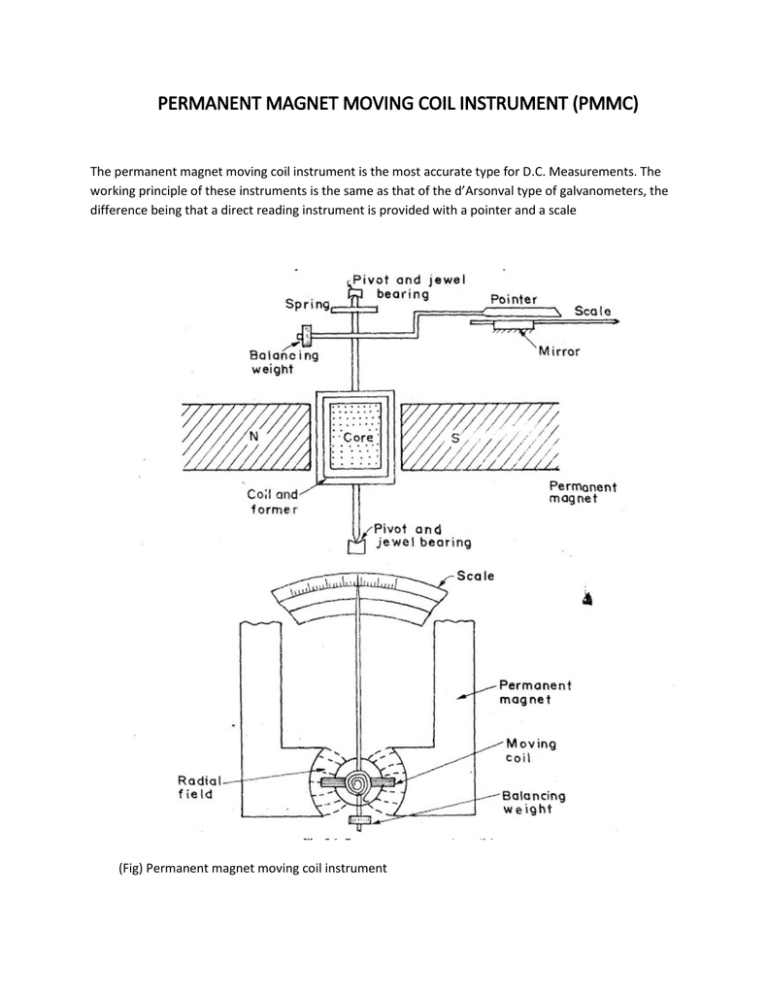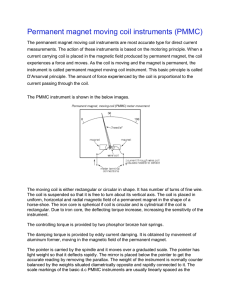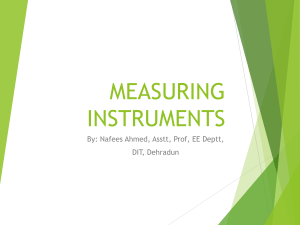PERMANENT MAGNET MOVING COIL INSTRUMENT (PMMC)
advertisement

PERMANENT MAGNET MOVING COIL INSTRUMENT (PMMC) The permanent magnet moving coil instrument is the most accurate type for D.C. Measurements. The working principle of these instruments is the same as that of the d’Arsonval type of galvanometers, the difference being that a direct reading instrument is provided with a pointer and a scale (Fig) Permanent magnet moving coil instrument Construction of PMMC Instruments · The constructional features of this instrument are shown in Fig. · The moving coil is wound with many turns of enameled or silk covered copper wire. · The coil is mounted on rectangular aluminum former, which is pivoted on jeweled bearings. · The coils move freely in the field of a permanent magnet. · Most voltmeter coils are wound on metal frames to provide the required electro-magnetic damping. · Most ammeter coils, however, are wound on non-magnetic formers, because coil turns are effectively shorted by the ammeter shunt. · The coil itself, therefore, provides electro magnetic damping. Magnet Systems Old style magnet system consisted of relatively long U shaped permanent magnets having soft iron pole pieces. Owing to development of materials like Alcomax and Alnico, which have a high co-ercive force, it is possible to use smaller magnet lengths and high field intensities. The flux densities used in PMIMC instruments vary from 0.1 Wb/m to 1 Wb/m. Control When the coil is supported between two jewel bearings two phosphor bronze hairsprings provide the control torque. These springs also serve to lead current in and out of the coil. The control torque is provided by the ribbon suspension as shown. This method is comparatively new and is claimed to be advantageous as it eliminates bearing friction. Damping Damping torque is produced by movement of the aluminium former moving in the magnetic field of the permanent magnet. Pointer and Scale The pointer is carried by the spindle and moves over a graduated scale. The pointer is of lightweight construction and, apart from those used in some inexpensive instruments has the section over the scale twisted to form a fine blade. This helps to reduce parallax errors in the reading of the scale. When the coil is supported between two jewel bearings two phosphor bronze hairsprings provide the control torque. These springs also serve to lead current in and out of the coil. Errors in PMMC Instruments The main sources of errors in moving coil instruments are due to · Weakening of permanent magnets due to ageing at temperature effects. · Weakening of springs due to ageing and temperature effects. · Change of resistance of the moving coil with temperature. Advantages and Disadvantages of PMMC Instruments The main advantages of PMMC instruments are · The scale is uniformly divided. · The power consumption is very low · The torque-weight ratio is high which gives a high accuracy. The accuracy is of the order of generally 2 percent of full-scale deflection. · Using different values for shunts and multipliers may use a single instrument for many different current and voltage ranges. · Since the operating forces are large on account of large flux densities, which may be as high as 0.5 Wb/m, the errors due to stray magnetic fields are small. · Self-shielding magnets make the core magnet mechanism particularly useful in aircraft and aerospace applications. The chief disadvantages are · These instruments are useful only for D.C. The torque reverses if the current reverses. If the instrument is connected to a.c., the pointer cannot follow the rapid reversals and the deflection corresponds to mean torque, which is zero. Hence these instruments cannot be used for a.c. · The cost of these instruments is higher than that of moving iron instruments. Source : http://mediatoget.blogspot.in/2011/12/permanent-magnet-moving-coilinstrument.html



